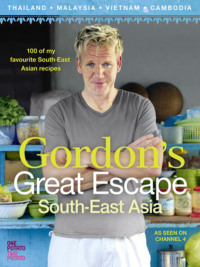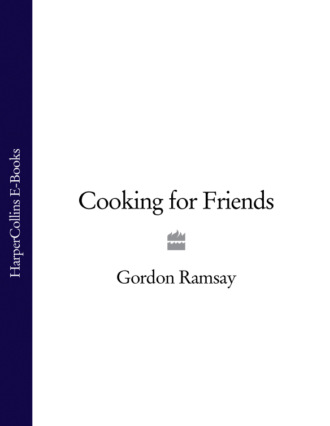
Полная версия
Cooking for Friends

Cooking for Friends
Gordon Ramsay
Food Mark Sargeant
Text Emily Quah
Photographer Ditte Isager
Stylist Christine Rudolph
Art Director Patrick Budge

Table of Contents
Cover Page
Title Page
Introduction
Hot and Cold Soups
Chilled Cucumber Soup
Curried Cauliflower and Cheddar Soup
Roast Chestnut, Parsnip and Apple Soup
Asparagus Velouté
Alnwick Soup
Broccoli, Stilton and Pear Soup
Conger Eel Bisque
Italian-Style Turnip Soup
Cornish Crab Soup
Oxtail Soup
Shropshire Summer Soup
Crayfish Chowder
Jacket Potato Soup with Sour Cream
Creamy Sorrel Soup
Pasta and Grains
Farfalle with Bacon, Peas and Sage
Fresh Tagliatelle with Stilton and Mushrooms
Grilled Vegetable Lasagne
Conchiglie with Meaty Tomato Ragù
Penne with Baked Pumpkin and Rosemary
Spaghetti with Broccoli, Garlic and Chilli
Chorizo, Broad Bean and Mint Couscous
Linguine with Lemon, Feta and Basil
Smoked Haddock with White Beans and Parsley
Gordon’s Posh Kedgeree
Spinach, Mushroom and Ricotta Cannelloni
Goat’s Cheese, Beetroot and Lentil Salad
Wild Mushroom Barley Risotto
Herby Rice Pilaf with Pistachios and Almonds
Fish and Shellfish
Fish Curry with Lime and Coconut Rice
Breaded and Fried Oysters with Sauce Gribiche
Smoked Trout Pâté with Horseradish Cream and Melba Toasts
Whiting in Piquant Tomato Sauce
Stuffed Bream Wrapped with Bacon
Thai-Style Fishcakes with Sweet Chilli Sauce
Clams with Old Spot Bacon
Sea Bass with Olives, Tomatoes and Fennel
Grilled Herrings with Harissa
Red Mullet with Tomatoes, Olives and Anchovies
Fisherman’s Stew
Poached Halibut with Creamy White Wine and Tarragon Sauce
Devilled Mackerel with Tomato and Fennel Salad and Horseradish Potatoes
Grilled Scallop and Prawn Brochettes with Coriander and Chilli Butter
Meat and Poultry
Poached Rabbit Legs with Gremolata
Pork Fillet Stroganoff
Home-Made Bangers
Classic Mixed Grill
Angus Beef Olives
Corn-Fed Chicken Legs with Braised Peas and Onions
Goat Curry
Roast Loin of Pork with Bramley Apple Sauce
Sweet Potato and Duck Rösti with Fried Duck Eggs
Honey Roast Ham
Cider and Honey Roast Leg of Lamb
Lamb Shank Cassoulet
Roast Rib-Eye with Caramelized Shallot and Red Wine Gravy
Lamb Stew with Bacon, Sweet Onions and Prunes
Braised Chicken Legs with Honey and Five-spice
Duck Breasts with Port and Cherry Sauce
Pies and Tarts
Raised Game Pie
Shepherd’s Pie with Branston Pickle
Cornish Chicken Pie
Smoked Salmon and Horseradish Cream Tartlets
Fish Pie with Oysters and Scallops
Spinach, Feta and Pine Nut Tart
Crab and Tarragon Tart
Artichoke, Asparagus and Ham Quiche
Lemon, Leek and Dolcelatte Tart
Wild Mushroom Tart with Parmesan and Walnut Pastry
Vegetables and Salads
Walnut, Celery, Chicory and Apple Salad
Roast Winter Vegetables
Glazed Brussels Sprouts with Chestnuts and Pancetta
Roasted Tomatoes with Marjoram
Spicy Cauliflower Stir-Fry
Braised Celery Hearts with Bacon
Caramelized Fennel and Red Onions
Artichokes Braised with Onions and Lardons
Chicory, Goat’s Cheese and Strawberry Salad with Pine Nuts
New Potato, Pea and Broad Bean Salad with Mustard Dressing
Grilled Aubergines with Balsamic, Feta and Mint
Mixed Mushroom Salad
Braised Red Cabbage with Bramley Apple
Pickled Onions
Home-Made Piccalilli
Puddings and Ices
Pear and Frangipane Tart
Autumn Fruit Salad with Thyme and Ginger
Strawberry and Champagne Granita
Caramelized Apple Pie
Summer Berry Trifle
Peach, Raspberry and Ginger Crumble
Baked Gooseberries with Honey and Almonds
Fig Ice Cream
Cinnamon Rice Pudding with Apricot Compote
Custard Tart
Lemon Meringue Pie
Bakewell Tart
Poached Rhubarb with Ginger Ice Cream
Mixed Berry Tartlets with Vanilla and Peach Cream
Blackberry Sorbet with Shortbread Fingers
Chocolate and Coffee
Chocolate Swirl Cheesecake
Double Chocolate Parfait
Chocolate Chip Pancakes with Orange Brandy Sauce
Sticky Toffee and Chocolate Pudding
Chocolate and Coffee Pots
Black Forest Cake
Dark Chocolate Marquise
Coffee and Almond Crunch Cake
Chocolate Roulade with Chocolate Chestnut Cream
Basics
Index
Acknowledgements
About the Author
Copyright
About the Publisher
Introduction
As a chef, I work at a thousand miles an hour, but when I’m at home, I want to slow down. I leave my chef’s jacket at work, and I walk into a domestic setting, where everything is completely different. At home, our kitchen is family-run, and it’s a relaxed place. A lot of people see cooking as a chore, but we bring an element of fun into it. For me, it’s a therapy, and it’s happening more and more that I cook with Tana and the children, especially Megan, my oldest. The kitchen is open-plan, with a large sofa and space to unwind. The focus is on the stove, which was built in Paris. It needed a concrete plinth as its foundation, to carry the weight, and after it was installed, the kitchen was built around it. The stove has a chrome-faced, water-cooled frontage so the kids can’t burn themselves while they slice spring onions or grate fresh parmesan.
I can’t sit at home with my feet up, reading the newspaper. But having said that, I am beginning to learn about being calm. Everyone always imagines that it must be hectic in the Ramsays’ kitchen, but it’s not. We turn cooking into serious fun. To an extent, everything we do is spontaneous. We’re very lucky in that we have some great farmers’ markets nearby. The kids will go and buy cheese, fresh organic chicken, and a selection of the farmers’ vegetables. They become totally involved in the shopping, putting aside a percentage of their pocket money for good measure. They love that.
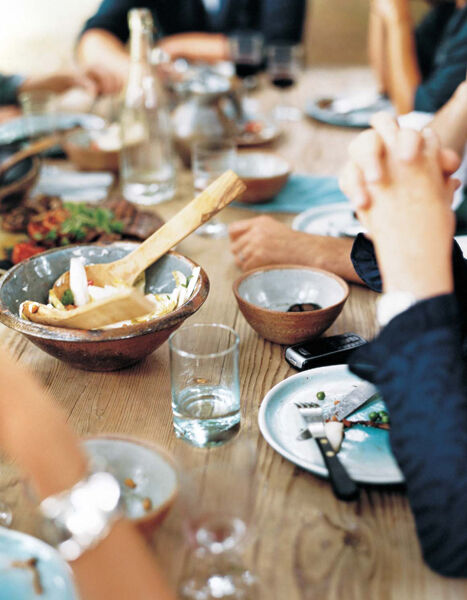
You get a young child to pay for a kilo of turnips or carrots, and then see how excited they are about what’s on the plate later. They get pocket money according to age. Megan’s nine, so she’s on £9. The twins, Holly and Jack, are on £8, and Tilly is on £6. They all wait for their birthdays because they know they’ll get a pound increase. They are learning that in order to live well and have a healthy lifestyle, they’ve got to eat well. If they never pursue cooking as a career, that’s not going to upset me. I just need to know that they can fend for themselves in the kitchen.
The naughtiest child on the day gets to do the washing-up. Whoever’s not on washing-up duty will set the table. We do have a dishwasher, but it’s rarely used, unless we’ve got a big party going on in the garden. I think the kids need to know what it’s like to wash up. When I was a child, we had a cleaning rota at home. I didn’t grow up with dishwashers and everything being done for you. As four children, we were all involved, and Mum managed a strict rota, so no one escaped their turn at the washing-up, even though we had busy lives: me with my football and the others with their music.
I’m a bit old-fashioned in this way. I don’t have rules and regulations at home, but what I do have is a very hands-on family. It’s not me standing there, cooking away and everyone watching. On Saturday morning, after the girls have been to the gym and Jack has got back from football, we come back and prepare a late lunch together. We won’t eat dinner until seven thirty, eight o’clock, and then it will be a slow braise. For
Sunday lunch, we have friends and family round, and over the weekend, we might indulge in a dessert. On Monday to Friday, it’s a substantial main course, followed by fruit.
Not everything comes from the farmers’ market. It would be great, but just not practical. Tana will shop two or three times a week at a supermarket, and I have to say that some of the supermarkets are doing some really good, interesting food lines. Out of respect for real quality ingredients, we also go to specialist purveyors, like Randalls, our butchers. Knowing where your food comes from and being able to trace it right back to its source is important to me.
I’d rather spend more and eat less, buy the best quality ingredients and savour them, buy what we need and no more. Sometimes I find it embarrassing when I see the amount of food that we, as a nation, waste.
I find it frustrating at how we are forgetting that there has always been a traditional British cuisine, and it doesn’t have to revolve around steak and kidney pie, or fish and chips. I remember watching my mother cook at the Cobweb tearooms in Stratford-upon-Avon, making ham hock barley soup, white veal stew, the most amazing honey-glazed roast ham, and, of course, all served with chips. What you don’t see nowadays is the way she used to stud the ham with cloves and caramelize it. All that forgotten, unfashionable stuff was traditionally British. Wonderful, but forgotten in our haste to experiment with modern fads.
We are at risk of trying to make food too sophisticated as we move along, changing ingredients to follow what’s in vogue. The words ‘trendy food’, ‘trendy restaurants’ and especially ‘trendy chef’ make me cringe. It is not always necessary to use foie gras with the finest fillet steak and line-caught turbot. Sometimes it’s just better to braise some oxtail and cook with mackerel, pollack or gurnard.
I’m always excited around food. There are so many opportunities to prepare and eat good food in the home if you have the patience and determination. Once you’ve got good at making amazing fresh pasta, you will want to make ravioli. Once you’ve mastered the perfect ravioli, you will want to get more intricate with the filling. A domestic kitchen is a far superior place to what it was ten years ago. And we’re competitive as a nation. We want to outdo our neighbours. We know and understand the importance of eating well, so mix that with our natural peacock tendency to be the one who hosts the best dinner parties, and you are on the path to a whole new dimension in your life at home.
But don’t get overconfident and miss the point when preparing a dinner party. Lighten up, have a glass of wine. Have your guests in the kitchen with you, and instead of showing off to them, involve them. Delegate the starter and the dessert while you tend to the main course. What can be difficult for me when going to dinner parties is when people hang on your every forkful. The food has been prepared in order to be enjoyed. It should be relaxing, not there to take you into a stress zone.
The palate can be educated. It’s a matter of learning, of discipline and of practice. It is also the best reason in the world to stop smoking. Smoking will always dull your palate and confuse your taste buds. It’s a bit like playing football with your laces tied together.
I love to see an array of cookbooks on someone’s shelf so that I can see who excites people. And I love to see a top chef’s recipes domesticated for home use. I have hundreds of cookbooks, though slightly fewer now, after taking all of our Delia cookbooks to Oxfam. I was astonished when I saw her using canned mince. Where’s the feel-good factor in that sort of compromise? It just gives the wrong message. We’re one of the hardest-working nations in the world. We move forwards, not backwards. The phenomenal confidence that Delia gave people, the impact that she has had over thirty years, has to my mind been shattered in one book. It made me quite distraught and taught me never to invest in a football club, if that’s what it does to you.
I get nervous if people tell me that they follow my recipes word for word. A recipe is a guideline. Adding, subtracting, evolving it – that is part of the pleasure. If a particular herb is not to your taste, if you don’t like the strength of rosemary, say, by all means, use thyme, especially lemon thyme. If you prefer the purple basil in the middle of summer, then great (if you ever can get it). If you are not excited about using swede the way I am, then use celeriac. We don’t eat enough turnips or kohlrabies – in terms of flavour, they’re extraordinary. Adapting the ingredients is completely in your hands. But the method is what matters. The techniques in cooking are rigorous and imperative: they are your passport to a successful dish. Cooks must practise, practise, practise. Anyone can learn, but you need focus, proper understanding, and to go at the right pace, not running before you can walk.
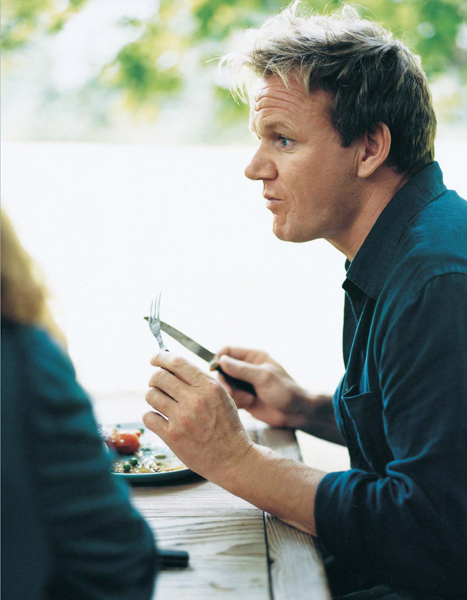
I’ll never forget, as a 22-year-old commis chef, working for the Roux brothers, all I wanted to do was bake, make the most amazing puff pastry, choux pastry, sourdough bread, and tomato and olive bread, using a natural yeast and fermentation. As a baker, you would start at midnight and work until midday. At half past midnight, it fell silent. All you could hear was the timers and the steamers for the second proof. On one occasion, I had to put together this marquise chocolate. Pascal, the young French pastry chef I was taking the section over from, could hardly speak English. He left me a box of After Eight mints, and said that I was to put a layer of chocolate mousse in the bottom of the mould and then add the After Eights. He wanted me to cut them in half and arrange them in threes in order to get this line of mints going through the mousse. I was thinking: this guy’s winding me up. He’s trying to get me into trouble. So I ate the mints instead.
The next day, Albert Roux came in. You have to give him one of everything, down to every bread roll, so that he can taste it all. I gave him the marquise, and he went bananas because it didn’t have the mints running through the centre. I couldn’t believe he would make an amazing chocolate mousse and stick After Eight mints in the middle. I got a bollocking. It got thrown in the bin, and I had to start again. I grew up on a council estate, but trained with the best. I’ve trained my palate with some of the greatest chefs, but sometimes you have to question the best. Cookery is quite a journey. Take nothing for granted.

Hot and cold soups

Soups are truly versatile: they can be as light or substantial as you want. In small amounts, a good soup can excite the palate in the form of a starter. Enrich the broth or bulk it up with chunky ingredients and it converts into a satisfying main course.
I fell in love with chowders when I spent a few months filming in America. We tasted amazing New England clam chowders on the East Coast. In San Francisco, one of the main treats was sourdough bread bowls filled with thick bisques and creamy soups. Once you’ve devoured the soup, you’re left with a flavourful bread bowl to break apart and savour. Whether you’re making an elegant blended soup or a more homely chowder, always start with a good base. Good-quality stock provides a depth of flavour that brings together all the elements in a soup. It is also important to season well.
Chilled cucumber soup
Curried cauliflower and cheddar soup
Roast chestnut, parsnip and apple soup
Asparagus velouté
Alnwick soup
Broccoli, stilton and pear soup Conger eel bisque Italian-style turnip soup Cornish crab soup Oxtail soup
Shropshire summer soup Crayfish chowder
Jacket potato soup with sour cream Creamy sorrel soup
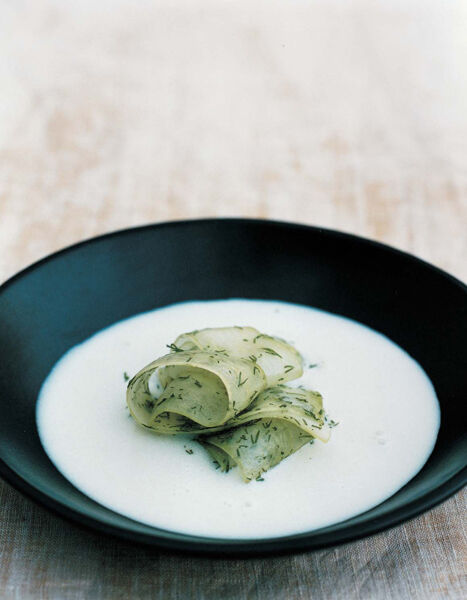
Chilled cucumber soup
Nothing beats a chilled cucumber soup on a hot, balmy day: it cools the body and whets the appetite. I find a little horseradish cream brings the soup alive, but you can leave it out to keep the flavours subtle and light.
SERVES 4
3 long cucumbers, about 650g each, straight from the refrigerator
lemon juice, to taste
1 tbsp olive oil
handful of dill, leaves roughly chopped, plus few fronds to garnish
500ml natural yoghurt
1-2 tbsp horseradish cream, or to taste
Peel the cucumbers and cut 2 lengthways into quarters. Slice off the seedy core from each quarter, then chop into dice. Put into a large bowl and set aside.
Peel the remaining cucumber into long thin ribbons using a swivel vegetable peeler. (Cut the ribbons in half if you find them too long.) Place in another bowl and toss with a little lemon juice, the olive oil, chopped dill, and salt and pepper. Cover with cling film and chill until ready to serve.
Put half the yoghurt, a pinch of salt and pepper and half the chopped cucumber into a blender. Whiz to a smooth purée. Press the purée through a fine sieve, pushing down hard with the back of a ladle. Discard the cucumber pulp in the sieve. Repeat the process with the remaining chopped cucumber and yoghurt. Taste and adjust the seasoning of the cucumber purée, adding 1 or 2 tablespoons of horseradish cream or a squeeze of lemon juice, as desired. Cover with cling film and chill if not serving immediately.
To serve, pour the cold soup into chilled bowls and garnish with the dressed cucumber ribbons and dill fronds.
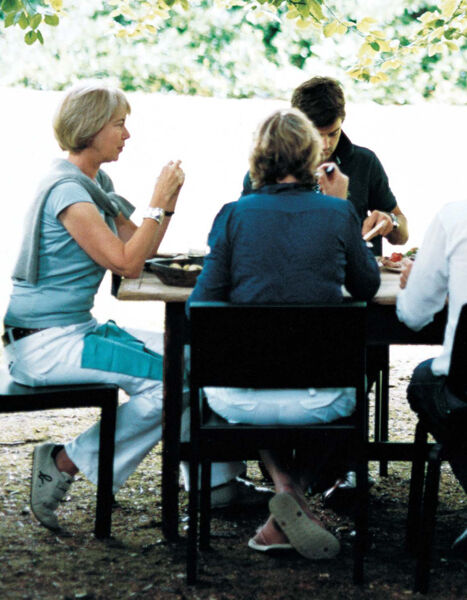
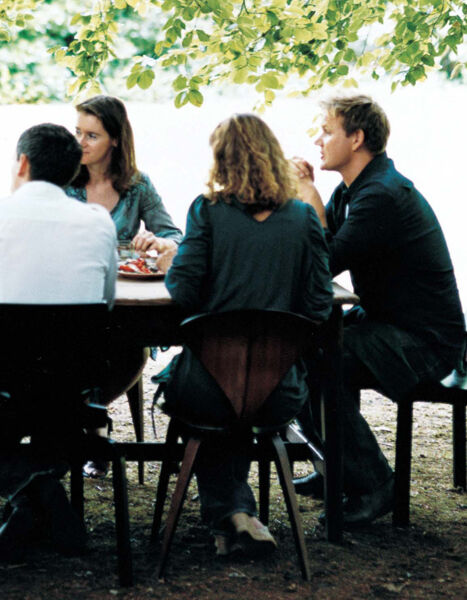
Curried cauliflower and cheddar soup
A little curry powder and saffron elevate the classic combination of cauliflower and cheese to another dimension in this soup. It is ideal as a winter warmer, as well as a comforting and welcoming treat for Bonfire Night. Delicious served with warm Indian bread or cheddar on toast.
SERVES 6 AS A STARTER OR 4 AS A LIGHT LUNCH
4 tbsp olive oil
2 medium onions, chopped
2 celery stalks, chopped
1 medium head of cauliflower, cut into florets
1 tsp mild curry powder
pinch of saffron strands
300ml hot chicken or vegetable stock (see pages 258-9) 300ml milk
100g medium or strong cheddar, grated
Heat half the oil in a large saucepan and add the onions and celery. Stir over medium heat for 3-4 minutes until the vegetables are beginning to soften. Add the remaining oil, cauliflower florets, curry powder and saffron, and season with salt and pepper. Stir well and cook for a couple of minutes. Cover the pan and cook for another 4-5 minutes, lifting the lid to give the mixture a stir every now and then.
Remove the lid and pour in the chicken stock. Bring to a simmer, then pour in the milk, adding a splash of water if the liquid does not cover the vegetables. Return to a gentle simmer. Partially cover the pan and simmer for 10 minutes until the cauliflower is very soft.
Use a hand-held stick blender to liquidize the soup, or blend the soup in 2 batches if using a regular blender. Return the soup to the pan and place over low heat. Bring to a gentle simmer, then slowly stir in the cheese to melt. Loosen the consistency with a little hot water if the soup is too thick, and taste and adjust the seasoning.
Roast chestnut, parsnip and apple soup
The subtle nutty flavour of chestnuts is paired with sweet apples and parsnips in this creamy soup. I love this earthy combination of flavours, and the soup makes for an easy lunch when served with cheddar on toast. Save time by using a packet of vacuum-packed chestnuts, or at Christmas, use up any leftover roasted chestnuts.
SERVES 4 AS A STARTER
20g butter
2 medium parsnips,
chopped 2 celery stalks, chopped 2 apples, peeled, cored
and chopped 250g roasted chestnuts,
shelled, skinned and
roughly chopped 600ml hot chicken or
vegetable stock
(see pages 258-9) few tbsp single cream,
to serve
Melt the butter in a wide pan and add the parsnips, celery and a little seasoning. Stir over high heat for 4-6 minutes until the vegetables are lightly golden. Tip in the apples and cook, stirring occasionally, for another 4-5 minutes until the apples are soft.



